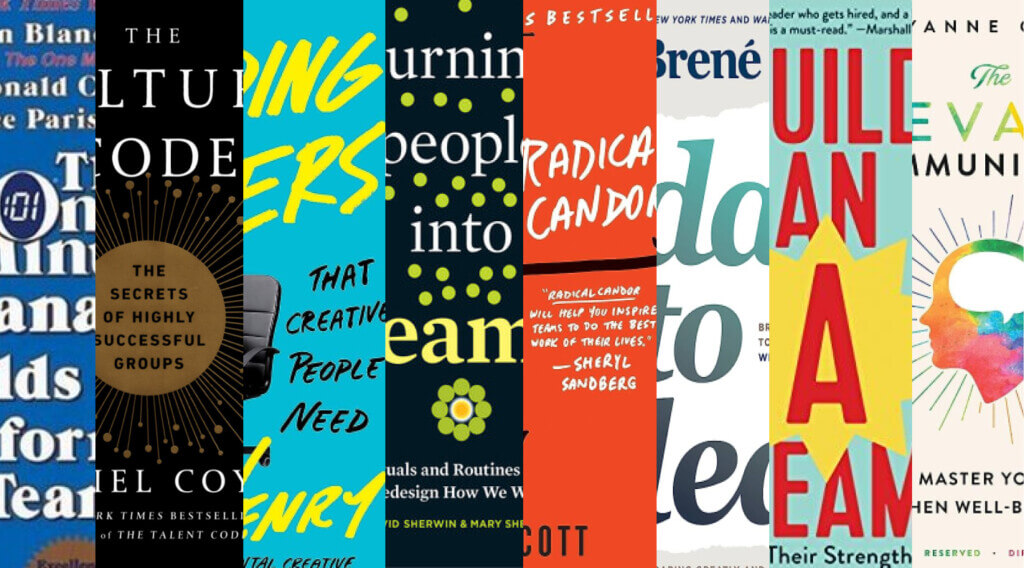Getting people to work effectively together is one of the most important aspects of leadership. Poor communication, different perspectives, clashing personalities, and lack of trust all conspire against you. Peak collaboration can seem like a fleeting ideal.
Want to strengthen your workplace culture and get everyone pulling together?
Here are 9 books from industry experts that provide powerful insights into how leaders can facilitate team cohesion, effective communication, and smooth collaboration.

1. The Culture Code: The Secrets of Highly Effective Groups by Daniel Coyle
“High-purpose environments don’t descend on groups from on high; they are dug out of the ground, over and over, as a group navigates its problems together and evolves to meet the challenges of a fast-changing world.”
Daniel Coyle
For The Culture Code, Daniel Coyle went inside some of the most impactful teams in the world to discover what makes a group highly effective.
Coyle uses the insights he gained while researching companies like Google and Pixar, as well as top sports teams, to examine the role organizational culture plays in success. He breaks down the elements that led to these successes and refines them into practical strategies you can start applying across your own team.
As a follow-up, it’s also worth checking out The Culture Playbook which features 60 exercises based on the insights contained in The Culture Code.

2. The Fearless Organization: Creating Psychological Safety in the Workplace for Learning, Innovation, and Growth by Amy C. Edmondson
The concept of psychological safety has been dominating conversations about collaboration in recent years. In part, it’s about creating an environment where everyone feels able to offer their thoughts and express themselves authentically. Professor Amy C. Edmondson, a pioneer of psychological safety, used her research into the topic to put together The Fearless Organization.
The book offers a solid foundation in the concept of psychological safety and the wide-reaching impact it has on individuals and businesses. Edmondson then uses detailed scenarios to show psychological safety in action, illustrating how it impacts our day-to-day interactions.
It’s a blueprint for creating an environment where people feel comfortable providing insights based on lived experience, taking risks, admitting to mistakes, and asking questions – all things which lead to a collaborative and innovative culture.

3. The One Minute Manager Builds High Performing Teams by Ken Blanchard, Donald Carew and Eunice Parisi-Carew
Strapped for time? The One Minute Manager Builds High Performing Teams is a brief, accessible read.
It’s a sequel to Blanchard’s original One Minute Manager and uses the bestselling formula to help you navigate the sometimes-rocky process of team building. Using a fictional leader and team as a framing device, the book guides you through the various developmental stages that come before true team cohesion. It also shows how you can adapt your management style to deal with each of those stages.
As with all the One Minute Manager books, it offers quick exercises that you can easily integrate into your day. These are helpful reminders of how even the smallest actions you make can have an impact on your team dynamics.

4. Radical Candor: Be a Kickass Boss Without Losing Your Humanity by Kim Scott
“Don’t let your focus on results get in the way of caring about the people you work with. I made that mistake when I first got to Google. I was laser-focused on getting stuff done, and fast. That slowed me down in the end.”
Kim Scott
Kim Scott developed Radical Candor in response to a dilemma many leaders face: How to provide the firm direction people need while remaining compassionate.
Through anecdotes from her own management career (including stints at Google and Apple), Scott demonstrates the importance of being honest as a leader and how that doesn’t need to come at the cost of empathy. She also provides powerful insights about developing team dynamics based on candor and how a lack of openness can negatively impact a team’s performance.
The book offers a clear framework to help you achieve an environment that prioritizes constructive feedback, accountability, and mutual respect. It will help you create a team culture built on openness and empathy, facilitating better collaboration.

5. Turning People Into Teams: Rituals and Routines That Redesign How We Work by David and Mary Sherwin
Turning People Into Teams helps you harness the power of ritual and routine to achieve better alignment between the people on your team.
The book is a highly practical toolkit, presenting routine-based methods that you can use to tackle various situations and problems. You’ll find techniques for defining a project’s purpose, navigating setbacks, and making the most of team members’ individual aptitudes.
If you learn best by doing, this book will give you lots of actionable ideas that you and your team can start experimenting with from day one. Hopefully, it will guide you toward systems and processes that work for everyone.

6. Herding Tigers: Be the Leader that Creative People Need by Todd Henry
“Creative people appear to be difficult because the expectations for a project keep changing midstream after they’ve done a tremendous amount of conceptual work that will have to be rehashed just to get back to the starting line.”
Todd Henry
Frustrated with how traditional management strategies failed to map onto the process of leading creatives, Todd Henry wrote Herding Tigers to help people lead through influence rather than control.
The book focuses on getting the balance right between freedom and challenge, by creating a stable environment that supports creative risk-takers, giving them enough direction to stimulate creativity. Henry also provides advice on how you can motivate people who are used to pursuing their own ideas to pull together in pursuit of a common goal.
A particularly interesting aspect of the book is the insight Henry gives on managing external pressures. If you struggle to balance your team’s needs with those of management and other stakeholders, you might find tiger herding particularly useful.

7. The Elevated Communicator: How to Master Your Style and Strengthen Well-Being at Work by Maryanne O’Brien
In The Elevated Communicator, Maryanne O’Brien explores the profound influence effective communication has on our ability to collaborate and build connections with others.
The book gives you the tools and frameworks you need to make the most of your default communication style and to borrow from other styles when a situation requires it. It then offers practical advice on how to use communication to build trust and strengthen working relationships.
The Elevated Communicator also focuses on the cyclical relationship between effective communication and well-being. O’Brien explores how a high level of well-being gives you the bandwidth you need to empathetically communicate, while that, in turn, improves the well-being of those around you.

8. Dare to Lead: Brave Work by Brené Brown
“If you choose courage, you will absolutely know failure, disappointment, setback, even heartbreak. That’s why we call it courage. That’s why it’s so rare.”
Brené Brown
In Dare to Lead, Brené Brown uncovers what it means to be a courageous leader.
The book posits that courageous leadership is about keeping an open mind, not shying away from difficult conversations, and making peace with uncertainty. That openness doesn’t just make it easier to build trust with people, it also means you feel more comfortable stepping back to give your team the space they need to collaborate and innovate without undue pressure.
Brown believes courage can be developed and has identified 4 necessary skills (broken down into 28 behaviors) that leaders can focus on to become more courageous. Through practical strategies and real-world examples, the book provides actionable steps that you can take to start developing your own courage.

9. Build an A-Team: Play to Their Strengths and Lead Them Up the Learning Curve by Whitney Johnson
The not-so-secret secret to creating a highly effective team is a culture of continuous development. Building an A Team demonstrates how giving people opportunities to learn makes them feel valued as individuals and keeps them engaged at work.
This book gives you the tools you need to design a learning curve for each team member that plays to their current strengths and challenges them to acquire new ones. This strategy gives your team a broader range of skills and knowledge to draw from, making their collaborations even more effective.
Johnson also explores how investing in a learning culture encourages a team-wide spirit of adaptability. This shared growth mindset will help futureproof your team culture and ensure resilience in the face of new challenges.

Whatever collaboration challenges you’re facing, hopefully, one of these books has the answers you need to guide your team towards a better way of working together.





